“PHABA Sri Lanka” (Profes-sional Hairdressers and Beauticians Association), present “Sunsilk Style International”- hair and beauty festival on March 18, 19 and 20 at the Sirimavo Bandaranaike Memorial International Conference Hall (BMICH).
PHABA in Sri Lanka was established in February 2006 with the support of leading hair dressers and beauticians in the country, and has a membership of over 2000 making it the country’s leading hair and beauty association.
Chief organizer Shiran Perera highlighted that there will be many competitions open to hairdressers and beauticians from all over Asia on the three days.
On the first day there will be bridal attire competitions, floral arrangements and wedding décor, the second day the competitions will be based on low country bridal styles, nail art and bridal photography and the third day will be the Grand Championship.
The overall champion will be awarded the prestigious “Sunsilk Style International” Championship Trophy. Various hair contests such as Cut & Blow Dry Competition ( Ladies/ Gents), Fantasy Hair competitions etc are planned, added Mr. Perera.
This three-day extravaganza will benefit professional hairdressers and beauticians as well as those merely interested in seeing and enjoying the attractions. The latest international trends and techniques can be learned and experienced through lectures and demonstrations conducted by foreign experts. The evenings will have several entertainment items such as fashion shows, bridal shows and hair shows.
Veteran designer Senaka De Silva, consultant of PHABA explaining the line-up said March 18 will see a fashion show called Bridal Glamour which will showcase the talents of both local and foreign bridal designers, on March 19 there will be “Salon Trends”- where local hair dressing salons will present styles of 2011 and a flower show presented by bridal flower decor artists -Second Chance, and on the 20th “Hair Innovations’ presented by the talented members of the PHABA team.
Terracotta Warriors come to Sydney
In this new series, D.C. Ranatunga shares some travel highlights of a recent trip Down Under
The world famous Terracotta Warriors are among the biggest tourist attractions in China. One has to travel to Xian, acclaimed as one of the four great ancient capitals of China, to see the Terracotta Warriors and Horses, described as one of the greatest archaeological discoveries of the 20th century. The place where these were excavated was listed by UNESCO as a World Heritage site in 1987.
In Sydney right now is an exhibition of the Terracotta Warriors. Titled 'The First Emperor – China's Entombed Warriors', the exhibition is on at the Art Gallery of New South Wales. The exhibits include 120 artefacts from the First Emperor's burial site, terracotta warriors and chariots.
|
| Visiting Sydney: Life size terracotta figures of warriors (above) and horses arranged in battle formations (below) |
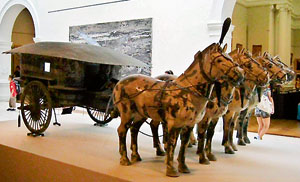 |
It was a memorable experience seeing these rare artefacts in Sydney during a recent visit. The well organised exhibition takes the visitor through a most interesting journey going back to the third century before the Christian era. At the entrance to the exhibition hall is a well carved horse driven chariot.
After having a good look at the chariot, you purchase a ticket and enter the hall, and are invited to sit through a 12-minute video tracing the history of how the warriors were found and how the excavations were done. It also describes the First Emperor's historic reign and sets the tone beautifully for the exhibition.
A group of farmers digging a well stumbled on the Terracotta Army in 1974. The mountainous region in Xian in Shaanxi Province was riddled with underground springs and watercourses.
Upon ascending the throne at the age of 13 (in 246 BC), Qin Shihuang (meaning the First Emperor) had begun to work on his mausoleum in readiness for his next life after death. It took 11 years to finish. He created a vast underground army to protect the tomb.
In 195 B.C., Liu Bang — the first emperor of the dynasty that followed the Qin — had ordered that 20 households should move to the site of the mausoleum of the First Emperor to watch over the tomb. To this day, 20 villages sit in the immediate vicinity of the mausoleum. Historians believe that the terracotta army may have been rediscovered by the direct descendants of the people left to guard it. For centuries, there were reports of pieces of terracotta figures and fragments of roofing tiles, bricks, and chunks of masonry having been occasionally dug up in the area.
After the discovery in 1974, archaeologists came to Xian in numbers to study and to extend the digs. They had established beyond doubt that these artefacts were associated with the Qin Dynasty (211-206 BC).
A year later, the State Council authorized to build a museum. When completed, people from far and near began to visit and soon Xian and the Museum of Qin Terracotta Warriors and Horses became landmarks on all travellers' itinerary.
Life size terracotta figures of warriors and horses arranged in battle formations are the star features at the museum. They are replicas of what the Imperial guards would have looked like in those days of pomp and pageantry.
Once you walk out of the video screening, you walk through a wide passage where huge maps indicate the exact locations of the excavations.They are attractively presented making the visitor stop and study.
Moving on to the next room you see a representative collection of artefacts. These include ceremonial vessels and bells, ornamental gold and jade, weapons and armour, palatial architectural remains, pottery and ceramics. Each carries a comprehensive description.
The exhibits continue in another room along with detailed accounts of the Emperor's triumphal journey to his becoming the ruler of the whole of China.
Next you meet the Terracotta Warriors – ten in all representing different ranks in the army. They include foot soldiers, generals, kneeling bowmen and horde riders. Each figure is different from the other and the remarkable attention paid to details makes them unique. Their physical features, their uniforms, footwear, headgear –are all carefully executed. A second chariot is also among the exhibits in the same room.
The museum shop with a vast variety of merchandise ranging from miniatures, posters, t-shirts, caps, DVDs, books, pens – offers souvenirs galore!
The four-month long exhibition is scheduled to end this month.
Mannar:Discovering a land of ancient lore
By Lankika de Livera
Steeped in legend, is the island of Mannar, 327 km from Colombo by land. It was, for decades caught up in the internal strife of the war in this land. A little distance from the town of Thirukeswaram on the mainland, a three km causeway takes you over to the island of Mannar. Covering an area of 130 square kilometres, it is the largest island belonging to Sri Lanka.
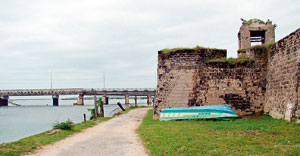 |
| The remains of the old Portuguese fort and inset, a towering Baobob tree. Pix by Lankika de Livera |
Legend has it that the graves of Adam and Eve lie here, in the precincts of a Moslem mosque near Talaimannar. The string of islets which forms a connecting line from the farthest end of the island, to India is called “Adam's Bridge”. According to Islamic lore, Adam is supposed to have crossed this natural bridge to get across to Ceylon to get to Adam's Peak.
The Adam's bridge set of islets could be visited by boat when the weather is good. One can hire a fishing boat for this purpose and the boat ride would be around 40 minutes to an accessible islet.
The other legend that encircles Mannar is from the “Ramayana” - the Hindu epic, where the story goes, Hanuman, the monkey general is said to have jumped over the Adam's bridge islets to come and rescue Queen Sita, the wife of Indian King Rama from King Ravana of Lanka who had abducted her. The so called islets are in reality a series of rocks, sandbanks and shallow mud flats. Interestingly, a 2002 research report claims that the Adam's bridge islets, according to NASA satellite images reveal the crossing to be man made, because of its composition. However, there is controversy over this as NASA states that the interpretation is incorrect. They say, it appears to be a naturally occurring chain of sand banks.
Historically, in the times of ancient Kings of Lanka, Mannar was known as Mahatiththa, an important maritime port--where ancient Arabian traders are believed to have introduced the Baobab trees to this country from Africa centuries ago. The other commonly occurring tree is “Umbrella Thorn”, commonly known as Acacia.
In the bygone days, Mannar was synonymous for its pearl banks. “More renowned is fishery of pearls of the west coast of Ceylon, bordering the Gulf of Mannar” - writes Emerson Tennant in his book “The Natural History of Ceylon”. Harry Williams in his book “Ceylon – the Pearl of the East” says that many centuries before the birth of Christ, Chinese writers praised the size and purity of pearls of Lanka. He says “The fishery of 1905 was the most successful and five thousand divers fished up eighty million Oysters from the bed of the ocean. They were sold for one quarter of a million pounds sterling”. However, the precious pearl Oysters do not seem to be there anymore.
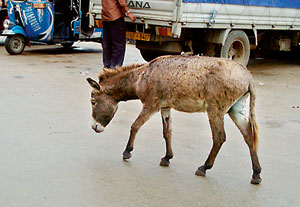 |
| Throwback to the past: Donkeys wonder the town |
From the colonial past, in 1560 - the ruins of a fort built by the Portuguese still stand just as you drive to the end of the causeway from the mainland. The top of the Fort is a great vantage point to see incoming traffic from the mainland. An ancient chapel with the altar intact, though in a state of ruin stands testimony to the presence of the Portuguese in this land. The Dutch had later fortified this fort. There are several stone tablets with engraved notices, in either Portuguese or Dutch. Braying donkeys now wander around in pairs or trios here.
The causeway is a good place to get down and stretch your legs. Unusual little shells like pipes and screw nails are visible just by the side of the causeway, if one were inclined to collect them.
The town of Mannar is small but bustling and amidst the traffic, wandering aimlessly are many forlorn looking donkeys.
The donkeys are another legacy left to us by colonial rulers, who used them for transporting goods.
From Mannar we drove to Toddaveli and onto Pesalai, going northwest of the island. Pesalai is a fishing village and making dry fish is the main livelihood of the people. Hundreds of fishing boats are moored alongside the beach and fishing nets are strewn carelessly around. Heaps of huge shells, caught in fishing nets are thrown in piles. We visitors picked up many to bring back home. Many of us bought dry fish at very low prices here. Hundreds of Whiskered Terns and Gulls circled the air calling enthusiastically, waiting for a chance to swoop and dive for fish.
Still driving north-west, we reached Talaimannar, the farthest point in the island of Mannar. Here we saw the light house and the now defunct pier which in those days was a hub of activity, a port of call for people travelling to and from India. There were many devotees among those who travelled to the Rameswaran temple.By the in-roads of Mannar we passed many of the unmistakable Baobab trees. Standing like towering sentinels amidst the scrub jungle around, the girth of some trees can be as large as 62 feet. The Baobab is a strange looking tree with such a broad trunk, but small branches sticking out like a brush and has a beauty of its own.
Within the boundaries of the island of Mannar is the Vankalai Sanctuary which is good for bird watching. In the District of Mannar, on the mainland, which is close to Murunkan, is the “Giants Tank” (Yoda Wewa) and the surrounding sanctuary. According to the historical chronicles it had originally been built in the 12th Century by King Parakramabahu the 1st. Restoration work had later been done by the British colonial rulers.
Another area for bird watching is the Madhu Road Sanctuary within which is the Catholic Shrine of “Our Lady of the Holy Rosary”, also known as the Madhu church.
Elegance tucked away in the hills
Bungalow guesthouses are springing up in surprising places in the interior of Sri Lanka as part of the new wave of tourism. They represent smart, pleasant places to stay within a village community; not isolated from reality but very much part of the local scene.
The first sign proclaiming the presence of The Elegant Guesthouse is on the right as you drive very carefully through the chaos that is Gelioya’s main street on the way from Kandy to Nuwara Eliya.
Look for the sign beside a gully and then turn right where the sign rather optimistically indicates a drive into the interior of 1.5km. The adventure begins here as the road degenerates to rubble, and half-built houses sprout from patches of tea and woodland.
You realise you are in an area of countryside undergoing transition. But persevere for the turnings are well sign-posted and, as the road crests a hill, an elegant guesthouse is indeed revealed. It looks refreshingly graceful, ingeniously simple and effective, contrasting with the dominance of views of deep valleys, soaring mountains and even, on a clear day, Adam’s Peak.
Although The Elegant Guesthouse has been four years in the making, its foundation goes back to the time when Britons John and Anne Brown visited Sri Lanka on holiday at the recommendation of a Sri Lankan who was working in Dubai. They liked Sri Lanka as much as he did and soon found themselves acquiring a small property in partnership with their Sri Lankan friend and his wife.The Elegant Guesthouse grew gradually and now has four double rooms. Three of these are extraordinary in that they open from a balcony on one side and have sliding doors onto a huge balcony on the other side, with blissfully magnificent views. The fourth room, much favoured as a honeymoon suite, has a private Romeo & Juliet type balcony overlooking the garden.
Perhaps that is why the guesthouse has become very popular for wedding and home-coming receptions and 200 guests can be catered for with ease, and at a modest cost. The menu, too, treats guests kindly, with prices that are lower than at guesthouses on the west coast.
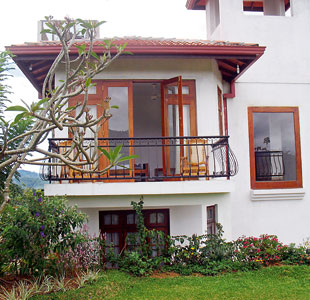 |
| Honeymoon suite, with a private Romeo & Juliet type balcony overlooking the garden |
The restaurant parlour has been expanded with a balcony and the whole of the interior is furnished with luxury faux-marble tiles, a sure touch of the Middle East influence. Each of the bedrooms has a fan and a small but perfectly formed bathroom with shower and hot water.
The décor is reassuringly bright with pleasant corner art and huge windows to take advantage of the staggering views. In the small reception area, Udaya, who runs the guesthouse with inestimable elegance, has constructed a small table used to frame his collection of coins and stones.
Unusual for a guesthouse (and even hotels) this one has a specially created bedroom for chauffeurs, complete with dedicated bathroom and television, leading off the small courtyard where vehicles park.
Its location between Kandy and Nuwara Eliya makes The Elegant Guesthouse ideal for a few days spent touring the area. Guests can expect to pay from Rs 4,000 for a double room, and even less in unseasonal months.
It was refreshing to discover, even above the cacophony of Gelioya and the Kandy/Nuwara Eliya road, a place so peaceful that birdwatchers adore it, foreigners like it for a few days break while they explore, and –- of course –- Sri Lankans appreciate it for family celebrations.
The Elegant Guesthouse proves that the new brand of tourist properties invading Sri Lanka doesn’t have to rely on spartan and expensive, architecturally-exaggerated boutique creations to be a hit.
The Elegant Guesthouse, No. 200/3 Sunflower Garden, Meewaladeniya, Handessa; tel: 081 2315830; www.elegantguesthouse.com.
Into the deep in search of
underwater beauty
By Malaka Rodrigo
James Cameron’s latest movie Sanctum screened at the Savoy cinema was based on an epic adventure about a group of divers trapped in a gigantic cave. Many perished attempting to escape through an underwater channel - some of them from exhaustion. Then came the shocking news that a stunt diver Agnes Milowka who was in the movie had died in a similar manner getting lost in murky waters while diving in a cave in Australia.
Cave diving is tagged one of the riskiest sports in the world. There are no known inland caves in Sri Lanka for cave diving but there are ample opportunities for recreational scuba diving at sea. Is recreational diving also risky, we asked some experienced divers.
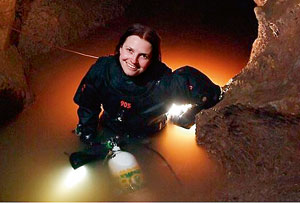 |
| Agnes Milowka on a cave dive |
“If you are properly trained, have the right equipment, are correctly prepared and know your limits; diving is not risky. It will open up a whole new beautiful world for you that others would envy,” says Nishan Perera, who has been diving for the last 15 years. Nishan who is also a marine biologist says there is plenty to explore for an amateur diver, from coral reefs to ship wrecks.
“But proper training is a must and the first step,” he pointed out. Those who are interested at diving should first get trained at a diving school. There are plenty of diving schools in Sri Lanka where a simple web search will link their contact details. Instructors will teach the novice diver the basic skills of scuba diving, how to operate the breathing equipment, survival skills etc. Once the novice is ready, he will be issued a PADI licence. This is given by the Professional Association of Diving Instructors and there are different licensing levels according to their level of training.
Once you get a PADI licence, you can join a diving team to go to the ocean. But like athletic events defined by distance, diving too is categorized upon the depth and complexities, so it is required to know your limit.
Sri Lanka has many shipwrecks, some accessible to a casual recreational diver, but many in the deep seas which need special skills to dive in. This is usually called ‘Technical Diving’ - where the dive is more than 40 metres deep. When you go deep in the sea, pressure will be a fact or that affects your body and you need to know how to control the air you breathe. You need to descend carefully and come back carefully too, taking breaks on the way. Technical diving is always for experienced scuba divers.
There is also a buddy system which twins people to ensure safety. The buddies operate as a single unit so that they are able to monitor and help each other in a crisis.
But for those who dare to go deep, it opens up a whole new wonderful world- the corals, colourful fish, and ship wrecks. “To me diving is meditative... it’s about being alone and enjoying nature peacefully while having a minimal impact on the environment,” says Asha de Vos, another young diver. Divers are also the first to witness the degradation of unique underwater environment.
The first marine sanctuary in Sri Lanka was established at Hikkaduwa in 1979 because some of the pioneers, the late Rodney Jonklaas, Sir Arthur C. Clarke, Mike Wilson and Lyn De Alwis saw the degradation of the marine environment and recommended the establishment of marine protected areas. Young divers today have teamed up under divers’ association SubAqua Club to become watchdogs to protect Sri Lanka’s marine habitats.
Cave diving
The Sanctum's stunt cave diver - 29-year-old Agnes Milowka claimed cave diving was the essence of exploration despite the risks. She said on her website "The rewards were worth it".
Agnes' website and her Flickr photostream are still active for anybody to witness her caving explorations www.agnesmilowka.com. To do cave diving, a diver needs a special licence. Florida, Mexico, Australia have some famous cave diving sites.
|
